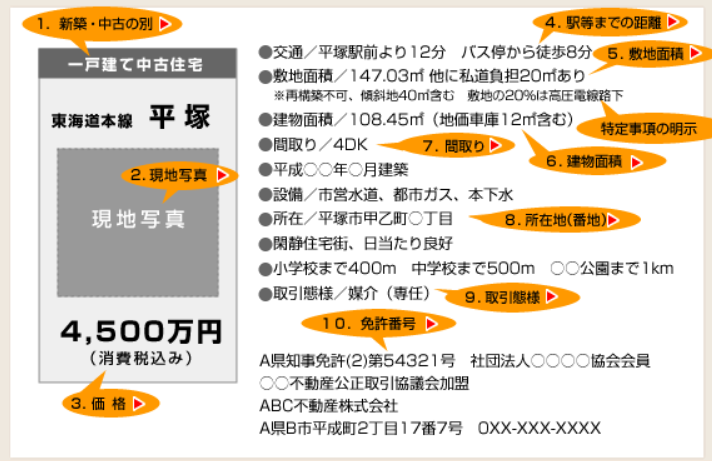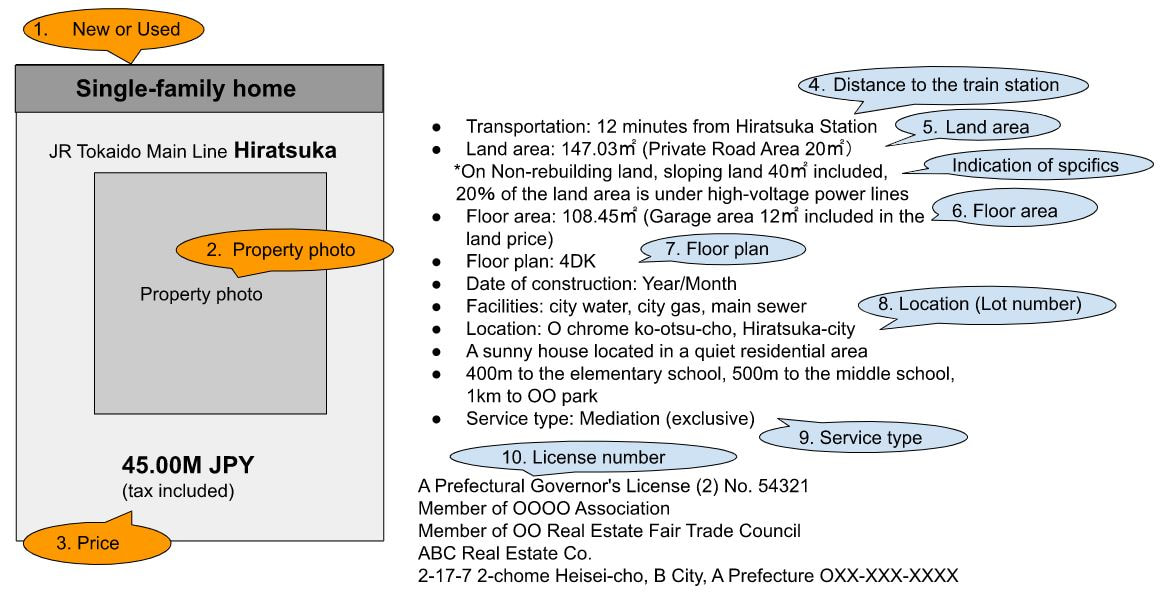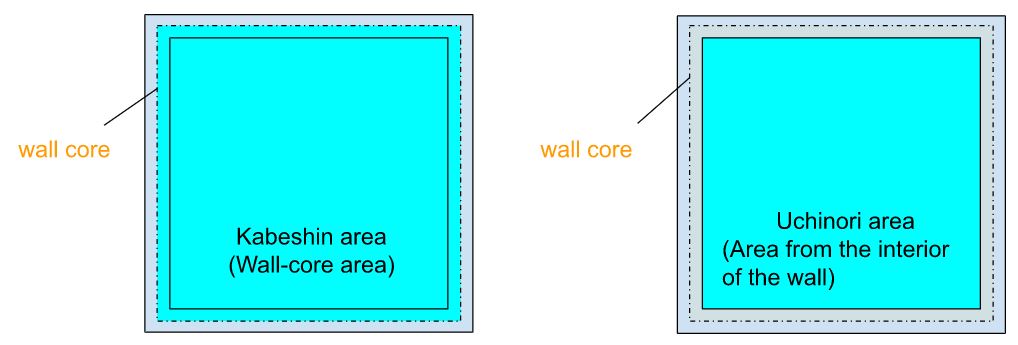Buying a House: Finding a Home 2How to Read Real Estate Advertisements (Basics) Since real estate advertisements contain a lot of information about individual properties, you need to properly understand the information in the advertisements when considering properties to buy. Point 1: Property search starts with gathering a wide range of information. To find a desired property, the first step is to gather information on a wide range of properties that might meet your requirements through the Internet, information magazines, newspaper inserts, and other means. Therefore, it is important to understand how to read the advertisements in order to correctly understand the contents listed in these publications. ∙ Search for information on condominiums, single-family homes, and commercial properties Point 2: All you need to know about real estate advertising terms and conditions Real estate advertisements are subject to a number of regulations regarding the method of display, etc., for the purpose of consumer protection. One is the regulation under the Real Estate Brokerage Act, which prohibits exaggerated advertisements and restricts when advertisements can be started. In addition, the "Fair Competition Code Concerning Real Estate Representation" ("Representation Code"), an industry self-regulation approved by the Fair Trade Commission, defines the manner and standards for displaying advertisements. Basic Real Estate Advertising Rules and Regulations The listing terms and conditions define the items that must be displayed in real estate advertisements and the standards for displaying them. The basic terms and conditions are shown in the chart below. *The above example is for general newspaper and magazine advertisements. 1. New or Used In real estate advertisements, the property is indicated as "new" when it is less than one year old and has not been occupied (no one has ever lived in the property). All other properties are indicated as "used." 2. Property photo As a general rule, photographs must be used in advertisements only if they are of a building that is actually for sale. However, if the building has not yet been completed, photographs of other properties may be used as long as they are identical to the building actually for sale, and this fact needs to be clearly stated. 3. Price The price including consumption tax for the building is displayed. 4. Distance to the train station, etc. The time required on foot is calculated as 1 minute (rounded up to the nearest minute) for every 80 meters of road distance from the station. The time required for waiting at traffic lights, going up and down pedestrian bridges, going up and down hills, crossing roads, etc. are not taken into account. In addition, the time required to reach the platform may be longer because it is based on the nearest station entrance to the property, not from the ticket gate. 5. Land area The area is displayed in units of square meters, and may not be displayed in units of "tsubo". The area indicated in square meters is divided by 3.3 to obtain the approximate area in tsubo. 6. Floor Area The total floor area is shown in square meters. If a basement or garage is included, a statement to that effect and the area of the basement or garage are to be indicated. Balconies in condominiums and two-tiered attic storage with high ceilings in the rooms are not included in the area. In principle, the floor area of a building is indicated by the "kabeshin" (wall-core) area measured from the center of the wall, but the area on the registration record (registry) is indicated by the "uchinori" area measured from the inside of the wall (interior side). However, for used condominiums, the internal area on the registration record (registry book) may be indicated. 7. Floor plan When describing a floor plan, indications such as 4LDK are often used. The numbers represent the number of bedrooms, L represents the living room, D represents the dining room, and K represents the kitchen. According to the Building Standard Law, bedrooms must have a certain amount of frontage for lighting and ventilation, so rooms that do not meet these requirements are labeled as a storage room (N) or service room (S). The indication code stipulates that 1 tatami mat, which indicates the size of a living room, is converted to a minimum of 1.62㎡. 8. Location (Lot number) The location of the property is indicated up to the lot number in the case of a newly built house for sale. In the case of an existing house, the lot number can be omitted, so it is often not indicated. In addition, the lot number is the number indicated in the registration record (registry), which may differ from the commonly used residential number. 9. Service type Whether the position of the real estate company which publishes an advertisement is "Seller" or "Agency" or "Mediation (agency)" is always clearly indicated. This transaction mode determines whether a mediating fee is necessary or not. Moreover, there is general mediation, full-time mediation, etc. in mediation, but in the case of full-time mediation, an indication like mediation (full-time) is permitted. 10. License number The name of the real estate company and its license number are listed so that you can confirm that the company has received the necessary licenses for real estate transactions. The number in parentheses indicates the number of times the license has been renewed, and the higher the number, the longer the company has been in business. Specific matters that must be clearly indicated If the use of land is subject to legal restrictions or the shape of the land is so irregular that it cannot be used effectively, this fact is clearly indicated in the advertisement. The specific items that must be clearly indicated in real estate advertisements are as follows. 1. Land in an urbanization control area
In principle, land cannot be developed or buildings cannot be constructed within the urbanization control area designated in the city plan, and this fact must be clearly indicated. 2. Land that does not legally abut a road Land that does not abut a road of 2 meters or more as stipulated by the Building Standards Law cannot be used for buildings. Such land is labeled as " no building allowed" or, in the case of an existing house, as " no rebuilding allowed." 3. Land requiring setback (road setback) Setback means that when the width of the road bordering the land is less than 4m, the land is set back 2m from the center of the road to construct a building. The setback is considered to be the road and no building can be constructed. The land that requires a setback is indicated as such. If the area of the setback required is approximately 10% or more of the total area of the land, the area is also indicated. 4. Land with an old house, etc. When there is an old house or an abandoned house on the land that is the subject of the transaction, it is indicated as "There is an old house" or "There is an abandoned house" etc. 5. Land under high-voltage lines When all or part of the land is under high voltage lines, a statement to that effect and the approximate area of the land must be indicated. When the construction of buildings or other structures is prohibited, the indication will read, for example, "No buildings or other structures are allowed under the high-voltage lines. 6. Land with slopes and significantly irregularly shaped land In the case of land that includes sloping land and the ratio of sloping land is approximately 30% or more, or even if the ratio is less than 30%, the fact that the land includes sloping land and its area is indicated if the effective use of the land is significantly hindered by the inclusion of sloping land, etc. In addition, the fact that the land is significantly irregularly shaped and hinders effective use of the land is also indicated. In the case of a markedly irregularly shaped lot, etc., which prevents the effective use of land, a statement to that effect is also indicated. 7. Land on or under a cliff not covered by a retaining wall If the land is on or under a cliff that is not covered by a retaining wall, this must be indicated. 8. Land with building conditions Land with building conditions is land that is sold or purchased on the condition that a building contract will be concluded with the seller of the land or a construction company designated by the seller within a certain period of time after the contract is concluded. The details of the building conditions and the measures to be taken if the building contract is not concluded are to be clearly indicated. Comments are closed.
|
Details
AuthorArrows International Realty Corp. Archives
June 2023
Categories
All
|





 RSS Feed
RSS Feed